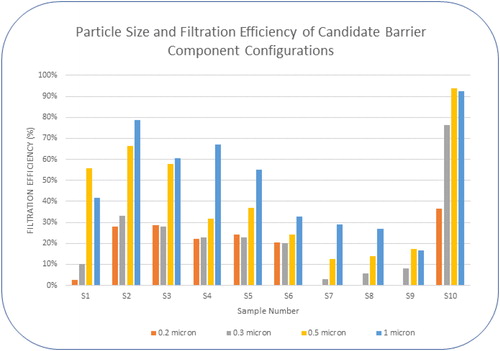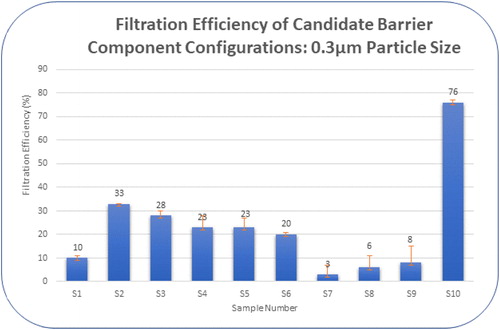Article title: From containment to harm reduction from SARS-CoV-2: a fabric mask for enhanced effectiveness, comfort, and compliance
Authors: Park, S., & Jayaraman, S.
Journal: The Journal of The Textile Institute
DOI: http://dx.doi.org/10.1080/00405000.2020.1805971
The authors carried out filtration efficiency tests on barrier component samples under more rigorous conditions than before to simulate minute ventilation associated with typical conditions of mask usage. Consequently, original and have been replaced with new figures and the discussion has been correspondingly updated to reflect the test results. A new reference pertaining to minute ventilation has been added at the end of list of references.
The text under the section 3.1.1. Barrier component has been updated as below:
To determine the ideal configuration that balances comfort with protection, it is important to assess the filtration efficiency and pressure drop (a measure of resistance to breathing) of the barrier component samples. Therefore, tests on these samples were conducted based on NIOSH standard test method for respirators (42 CFR 84). A 2% NaCl solution in distilled water was used to generate poly-dispersed aerosols (0.1–5 µm size range) using an atomizer in the experimental set-up based on ASTM F2299-03 (Jayaraman, 2012). The barrier component samples were cut to fit the 7.5 cm diameter filter holder. Since the mask will be worn for extended periods of time, especially in work settings, a flow rate of 30 liters/minute through the filter was chosen to be representative of the minute ventilation rate associated with typical heart rate in the range of 80-100 beats/minute (Zuurbier et al., Citation2009). The face velocity was 11 cm/sec. A LASAIR II particle counter in the experimental set-up measured the NaCl aerosol size distribution and number concentration with and without the samples to determine particle penetration, and hence, filtration efficiency. A differential pressure gauge was connected to the sample holder to measure the difference in the pressure before and after the sample (ΔP). Due to COVID-19 related constraints of time and lab access to carry out the filtration tests, the samples were not pre-conditioned in the lab to the standard conditions of 38 °C and 85% relative humidity. However, all the samples were tested in identical lab conditions, and so, the results are comparable for the purpose of this study. An N95 respirator was tested as a control (reference) during the tests.
shows the effect of particle size as it changes from 0.2 to 1 µm on filtration efficiency of the candidate barrier component configurations. The general trend is that the filtration efficiency increases as the particle size increases. Three distinct groups can be seen in the graph; in the first is the medical mask (S10) material with high filtration efficiency. The control N95 is similarly high, but is not shown in the figure. Samples S2 through S6 fall into the next group with filtration efficiency increasing from 21% to 79% as the particle size increases. Samples S1 and the handkerchief fabrics (S7–S9) have the lowest filtration efficiency, which are along the lines of those found in earlier studies with similar fabrics (Jayaraman, 2012). There was complete penetration of 0.2 µm particles for the handkerchief fabrics; so that is not seen in the figure. The maximum pressure drop (ΔP) was 12.5 mm for samples S2 and S3, which are well within the limits required for NIOSH certification of N95 respirators. Therefore, the candidate barrier component configurations will have negligible effect on air flow through them when incorporated into the proposed mask.
For comparing the filtration performance of the candidate barrier component configurations with the nominal 95% filtration efficiency of N95 respirators to filter out 0.3 µm size particles, their filtration efficiencies for 0.3 µm size particles from the tests have been plotted. As seen in , the two-layer woven fabric configuration has only a 10% filtration efficiency. When a filter is inserted between the two layers, the filtration efficiency increases – Samples S2 through S5 have filtration efficiencies of 33, 28, 23, and 23%, respectively). The piles in the fabric filter increase the surface area of coverage creating the opportunity to trap and arrest additional particles thus increasing the filtration efficiency. Furthermore, when the filter has piles on both sides of the fabric (filter 1 in Samples S2 and S3), the filtration efficiency is higher when compared to a filter with piles on only side (filter 2 in Samples S4 and S5) confirming that the amplification in filtration efficiency is due to the additional surface area. For samples with piles on both sides, the filtration efficiency is higher when the piles with longer length are facing the direction of air flow (S2) because the additional surface area provides better trapping of the particles than when the longer piles are on the other side of the fabric surface (S3). The orientation of the sample does not have an effect on the filtration efficiency when piles are present on only one side (S4 and S5). The commercial two-layer knitted fabric (S6) has a filtration efficiency of 20% while the medical mask material (S10) has an efficiency of 76%. The filtration efficiency of the handkerchief fabric increases from 3 to 8% when the number of layers increases from two to four.
Since the observed pressure drop (ΔP) in all the samples is less than what is allowed for the certification of an N95 respirator, the wearer would not experience any resistance to breathing from any of the candidate barrier configurations evaluated for use in the mask. In other words, all the barrier configurations would be comfortable from a breathability standpoint.
It is clear from these test results that even though the handkerchief fabric has a higher air permeability, its filtration efficiency even with four layers (S9) is only 8% and would not be a suitable candidate for the barrier component. While configurations S2 and S3 have a lower air permeability than the commercial two-layer knitted mask (S6), their filtration efficiency is much higher and so, would be better candidates for the barrier component. Sample S4 and S5 are better than the commercial mask in terms of filtration efficiency and have higher air permeability. Thus, based on these tests, the two-layer woven fabric with filter 1 has been chosen for the barrier component of the proposed mask. Since the mask architecture (Figure 2) is such that the filter can be replaced in the two-layer woven pocket, individuals with medical respiratory conditions could choose filter 2, which would give higher air permeability, but a lower filtration efficiency.
Also under the section 4.3. Discussion, some text has been updated which are shown below: … with filter 1 is lower (Samples S2, S3: 33 and 28%) than that of a medical mask (Sample S10_76%).
Below are the corrected images:
Figure 5. Effect of particle size on filtration efficiency of candidate barrier component configurations.

Below is the reference included to the article:

